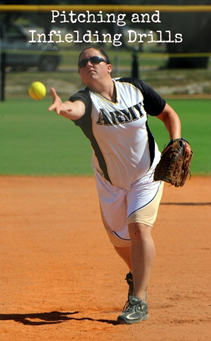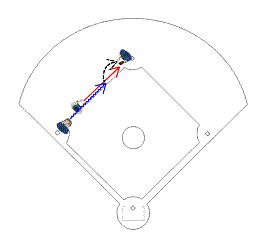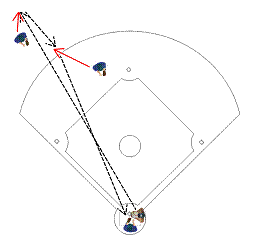|
3 Drills to Work on Your Pitcher’s Skills
Pitcher’s Position Ground Ball Series Let’s take a look at the pitcher’s position ground ball series. This is a ground ball series with no throw, just working the footwork, and then finishing off a ground ball series with a throw to each base. Now let’s focus on the pitcher’s position, working the ground ball series and throwing the ball to first base. When you carry out this drill, make sure that the pitcher goes through her game motion so she can work on her reaction time. Next let’s have the pitcher work the ground ball series and the throw to second base. She’s going to incorporate everything that we’re trying to work on: decelerating, receiving the ball, picking it up in a good athletic position, making sure she’s balanced when she gets ready to throw to second base. You’re going to see the long, the medium, and the short throw. Once again, it’s best to have the second baseman sitting on the bucket to force the pitcher to throw strikes to the base. Now have the pitcher work the ground ball series and throw to third base. Next, have your pitcher work the ground ball and the play goes home. You’re going to see a routine ground ball, a middle ground ball, and then a suicide attempt bunt so she can go ahead and pick it up and shovel throw into home. Let’s go ahead and take a look at some fly balls for the pitcher position. What you want to do as a coach is make sure you have a good communication system regarding how much area you want your pitcher to cover. Remind your pitcher that the quickest way to glove the ball, and get into a throwing position if you have to, is to allow that ball to get down closer to your body. Rundown Drill Once you do that, you’re able to make it more difficult for the runner to change directions. Next, you’ve got to make sure that your line, your throw to your receiving infielder, is a clear line and you’re not going to cross over the line of the base runner. Finally, you’ve got to make sure that when you throw, you allow the receiving infielder enough time to receive your ball. It’s a short, dart-like throw. You don’t have to take a full wind-up; you don’t have a lot of time. But you’ve got to get some good velocity on it so you can get that ball to your partner in time to make the tag. Go ahead and take a look right now at the mechanics of the rundown, strictly the timing and the mechanics of running down that runner and getting her out. What happens many times is that the infielders don’t do a good job of running as quickly as possible. Remember when we’re talking about the rundown, if the defender with the ball’s not running fast, then the person caught in the pickle doesn’t have to run as fast. So get them on a sprint. Most defensive setups in the rundown have the runner with the ball, once she tosses it she follows her throw. Then she’ll be in position to receive the rundown throw in case they end up going back in the other direction.
The next general infield drill is the relay drill, where all the infielders that are involved can work on their positioning, setting up the target, opening up and receiving the throw, and being in a position to throw the ball to the infield. Here’s what we’ll focus on as we work on the relay: receiving, making the target, opening up, and setting our throw to the intended base. As an outfielder, you want to go ahead and have a strong enough throw so the relay person doesn’t have to run out towards the outfield. By doing that, the relay person now has to shift their momentum back towards the infield.
|
|
|



 Your pitcher is a vital part of your team–with these softball drills, you can help your pitcher improve while also working on some general infielding exercises.
Your pitcher is a vital part of your team–with these softball drills, you can help your pitcher improve while also working on some general infielding exercises.




